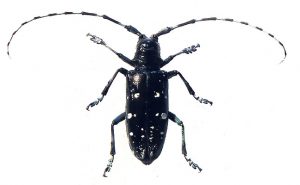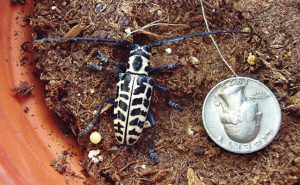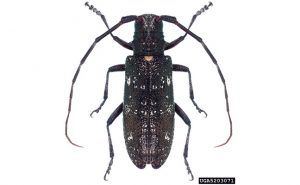-
Anoplophora glabripennis
Photo: New York State Integrated Pest Management Program
-
Plectrodera scalator
Photo: Razarax
-
Monochamus scutellatus
Photo: Natasha Wright, Florida Department of Agriculture and Consumer Services, Bugwood.org
Since its discovery in New York in 1996, the Asian longhorned beetle (Anoplophora glabripennis, or ALB) has attacked many valuable native tree species, including maples, birches, poplars and willows in Illinois (1998), New Jersey (2002), Massachusetts (2008) and Ohio (2011), according to the U.S. Department of Agriculture. Although these non-native beetles don’t travel far from year to year, humans help spread them by moving wood materials such as infested firewood.
Adult ALB have large, shiny black bodies with white markings and long antennae, with alternating black-and-white bands. They are 1.25 to 1.5 in. long. The most serious damage is done during the ALB’s larval stage. After hatching, small larvae feed under the bark, much like emerald ash borer larvae. But as ALB larvae grow, they chew tunnels into the heart of the tree. After pupating under the bark, the adults emerge from large exit holes — as wide as 0.5 in. in diameter — on branches and tree trunks.
There are two specific native U.S. beetles that are easily mistaken for ALB. The cottonwood borer (Plectrodera scalator), which colonizes poplars and willows, has a large, shiny black body with white bands or spots. However, there’s a lot more white on the bodies of cottonwood borers than on ALB. The antennae of the cottonwood borer also lack the white bands typical of ALB antennae. Larval feeding also is different. These native borers feed in the large roots and root collar of trees and emerge as adults from those roots, but there are no large round exit holes on tree trunks or branches.
The other native beetle most commonly mistaken for ALB is the white-spotted pine sawyer (Monochamus scutellatus). Although also dark in color, the male adult beetles have one white spot on their back, while the females are mottled brown. These native beetles are also smaller, usually about 0.75-in. long. Sawyer beetles and their larvae are attracted only to severely stressed, dying, or recently killed or cut trees. Sawyer beetles feed only on pines, spruces and conifers, whereas ALB aren’t attracted to conifers.
As spring gives way to the summer camping season, remind customers (as well as employees, families and friends) to not move firewood out of their respective counties. Instead, buy from local sources when traveling.
Contributor Dr. Georgia Peterson is an extension specialist for Michigan State University in East Lansing, Mich. She can be reached at petersog@msu.edu.



Leave A Comment